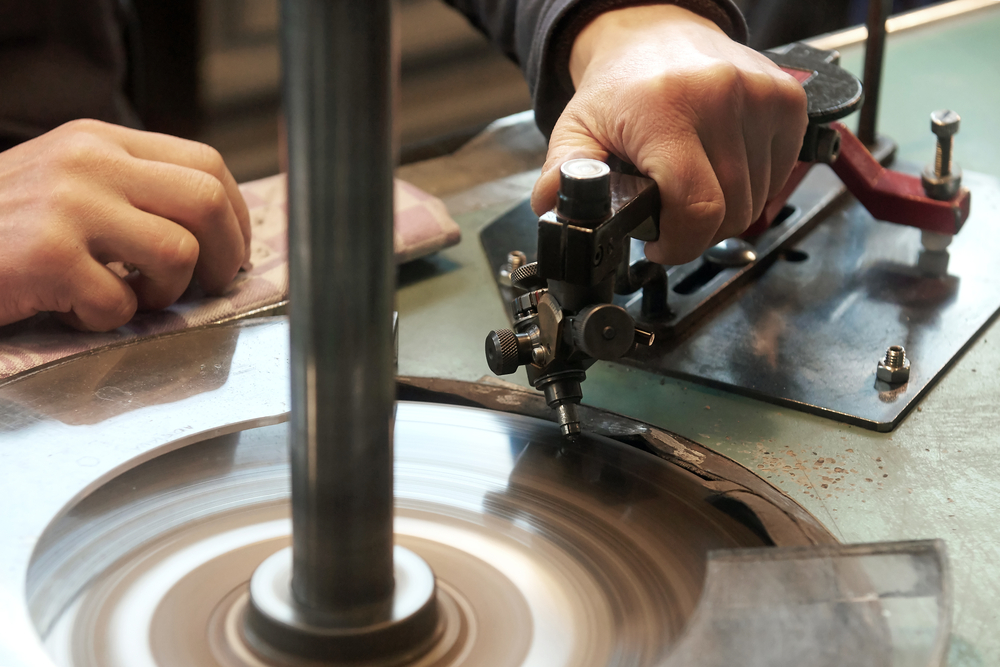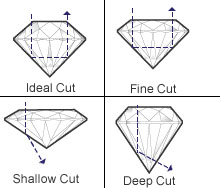4C's

Cut
Cut is the human contribution to a diamonds beauty, brilliance and fire. The way a diamond is cut can affect the other three C’s which are dictated by nature. Even if the diamond has perfect colour and clarity a diamond that has been cut poorly will appear dull and lifeless. One of the factors that make a diamond so rate and special is its ability to display a unique fire and brilliance.

A classic round brilliant diamond has 57-58 facets, the diamond cutter must place each of the stones facets and angles, which act as light dispersing mirrors, in exact geometric relation to one another in order to bring out the stone’s fire and brilliance.
There is a difference between the cut and the shape of a diamond. The shape is largely a matter of personal preference and is only limited by the skill and imagination of the craftsman.
A well cut stone will dramatically increase its beauty and therefore its market value. When comparing prices, make sure you are not only comparing size, colour and clarity but also the diamonds cut.
There are 7 traditional shapes for diamonds.

The cut is very important in terms of brilliance of the stone. The cut is composed of two parts: the proportions and the finished grade. Good proportions are necessary for the brilliance and “fire” of the diamond. Significant deviations from the ideal proportions make the stone look dull and unappealing. The proportions are only assessed for diamonds with a round brilliant shape. For all other cuts, proportions are measured, but no final evaluation is given, as in this area no international norms exist. The enormous variation in the proportions between the different fancy cuts, make it impossible to judge them according to one ideal.
Carat
The weight of a diamond is expressed in carats 100 points = 1ct. Bigger is not necessarily better. A carat is a term referring to the weight, not the size of a diamond. One carat is equal to 100 ‘points’, so the weight of a diamond of 50 points is 0.50 carats, or half a carat. The carat weight of a diamond alone is meaningless, as a large stone is not particularly valuable if it lacks high-grade colour, brilliance and purity. In fact, sometimes stones may be poorly cut to maintain weight at the expense of quality. But large diamonds of equal quality to small diamonds are more valuable, as larger stones are rarer.
Clarity
The clarity of the diamond is determined by its internal and external characteristics. The best quality is called “loupe clean.” This means that upon examining the diamond with a loupe (x 10 magnification), no inclusions can be found.
The greater the clarity of a diamond, the more brilliant it appears. Almost all diamonds contain minute traces of non-crystallized carbon or small non-diamond crystals.
These are called inclusions and may be interior or exterior inclusions. Flawless diamonds are extremely rare and valuable because the fewer the inclusions in the stone, the less interference with the passage of light through it and the greater the sparkle. MOst diamonds contain blemishes on the outside of the diamond or inclusions trapped inside the diamond. Your jeweller scruitnizes each diamond a 10-power magnification to view any flaws. Small inclusions will probably not be visible to the naked eye and are unlikley to mar the stone’s beauty.
Clarity grades range from FL (Flawless) for a perfectly clean diamond, even under 10-power magnification, to an I3 stone where the diamond is so full of inclusions it is both ugly and breakable. The cleaner the diamond the rarer and more expensive it will be.
Colour
The colour of a diamond depends on the presence of more specifically, the absence of colour in diamond. The majority of good quality diamonds are colourless or near colourless. Diamonds can, however, be found in nearly every colour. Exceptional colours are for example red, blue and pink.
When the carbon is compounding to create the diamond, if natural gasses enter through the stone as it is forming, it will change the colour situation leaving traces of colour within the stone. Due to the effects of nature you would expect all stones to have some trace of colour within. Diamonds with purer colour saturation have a greater capacity to reflect and refract light allowing greater brilliance. White diamonds come in various shades, with most having a barely perceptive yellow, grey or brown tint. The highest quality diamonds are describe as colourless and are extremely rare and valuable.
Diamonds colous is graded on a letter scale beginning with D (colourless) and moving through the alphabet to Z. A single increase or decrease in the colour grade can make a price difference of thousands of dollars, depending on the size of the diamond. With diamonds of “D” through to “Z” colours lined up in a row, the steady progression as the colours get deeper is easily seen. But generally, to the unaided eye, colour cannot be detected in a mounted diamond until well down into the K, L or M range.
Even experience diamond graders have a difficult time distinguishing between any one colour grade. When purchasing a diamond, don’t take any chances. Always make sure the stone is accompanied by a certificate, best is GIA.

Fancy colour diamonds make up a small but exotic part of the diamond industry. These diamonds include red, blue, green and pink, as well as the stronger yellows. They also come in combinations such as orange/ yellow or grey/ blue. Red and green are the rarest fancy colours, These stones are expensive and quite rare.
Flourescence
Apparent colour can also be influenced by the tendency of some diamonds to react to the ultraviolet radiation in daylight and fluorescence light bulbs. Fluorescence grades of; faint, inert, negligible and medium can only be detected by a trained gemmologist. A flourescence grade od strong or very strong can make a diamond with a near colourless grade look even whiter yet in some instances give the diamond a slight hazy or oily appearance. Diamonds with strong or very strong fluorescence are priced slightly lower than other diamonds.


